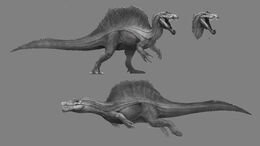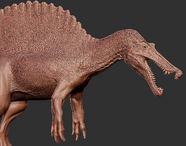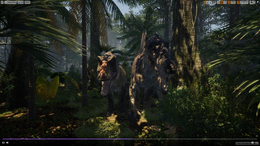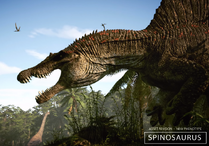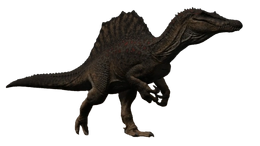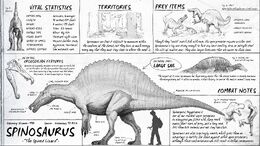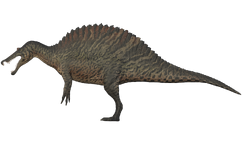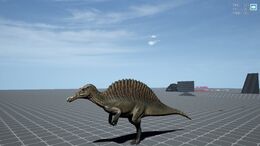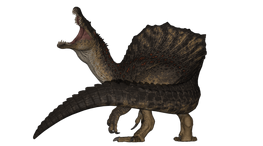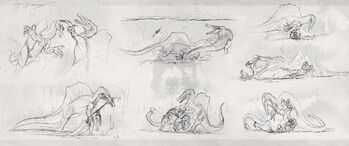Spinosaurus is a genus of spinosaurid theropod from the lower Albian to lower Cenomanian stages of the Cretaceous period. There may have been two species; S. aegyptiacus and S. marocannus.
Spinosaurus was added to The Isle in Patch 0.1.11.2919.
In Real Life.[]
"Spinosaurus" remains are known from both Egypt and Morocco, indicating it probably lived across North Africa. Spinosaurus was a highly derived member of its family.
A 2010 publication by Romain Amiot and colleagues found that oxygen isotope ratios of spinosaurid bones might indicate semiaquatic lifestyles. Isotope ratios from teeth from Baryonyx, Irritator, Siamosaurus, and Spinosaurus were compared with isotopic compositions from contemporaneous theropods, turtles, and crocodilians. The study found that, among theropods, spinosaurid isotope ratios were closer; albeit not similar; to those of turtles and crocodilians. Siamosaurus specimens tended to have the largest difference from the ratios of other theropods, and Spinosaurus tended to have the least different from other large theropods. [1]
The legs of Spinosaurus were reduced compared to other spinosaurid species. The 2014 thesis speculated that Spinosaurus was highly aquatic; spending most of its time in the water, and only occasionally venturing onto land. The High oxidation of its bones, as well as an abnormal bone density (seen as an adaptation for increased buoyancy), interpreted as it resided near or in water for much of its life.
Specimen FSACK-KK 11888 found in the Kem Kem Beds in 2014 exhibited leg lengths considerably shorter than what was previously conceived of Spinosaurus, having the only tibia, fibula, and femur found of any Spinosaurus specimen since its discovery by Ernst Stromer in 1915. FSACK-KK was the fragmentary remains of a subadult. It has been proposed that the hind legs could have still lengthened as it reached its full size, but not to the extent as previously believed and depicted.
It has also been proposed that Spinosaurus may have been an obligate or facultative quadruped when it ventured onto land. Its true mode of terrestrial locomotion is unclear; albeit quadrupedal movement theory has fallen out of favor as no known spinosaurid species has shown any inclination towards such a locomotion method.
A 2018 study publishing by Donald Henderson et. al. challenges the 2014 claim that Spinosaurus was semi-aquatic. By studying the buoyancy in the lungs of crocodilians and comparing it to the lung placement in Spinosaurus, his simulations shown that the Spinosaurus could not sink or dive below the water surface. It was capable of keeping its entire head above the water surface while floating, similar other theropods. This resulted in an entity prone to tipping and Henderson argues Spinosaurus had to continually paddle its hind legs to prevent itself from tipping over onto its side, something that semiaquatic animals do not need to perform. Henderson, therefore, proposed that Spinosaurus probably did not hunt completely submerged in water as previously hypothesized, but instead would have spent much of its time on land or in shallow water; he also argued that osteosclerosis would not have changed a theropod's buoyancy to a significant extent; as the previous claim interpreted; the analysis also found that Spinosaurus probably was competent at bipedal terrestrial locomotion; the center of mass was instead found to be close to the hips, allowing Spinosaurus to stand upright like other bipedal theropods [2][3]
Its sail was oddly shaped, with a dip in the middle between two tall points. The sail was likely used for multiple purposes; sexual display, appearing larger against other carnivores.
The animal's jaws were built for grasping, but not for resisting torsion; indicating fish may have been it's the primary source of food, although considering direct evidence for spinosaurids' rather generalistic behavior/diet, it is likely that it possibly hunted prey animals and stole/scavenged meals of other predators such as Carcharodontosaurus.
Here are 2 documentation excerpts on Youtube: "Spino fishes" and "Spino vs Carcharodontosaurus"
In 2020, a new fossil find, which included a good sized section of the tail, showed that Spinosaurus had tall spines on its tail, showcasing that Spinosaurus could swim. Tests were conducted on how effective this new tail was compared to other theropods, a crocodile, and a newt in how much thrusting power it could have in the water. It shown that it preformed much better than the other theropod tails and was similar to the crocodile and newt tails, making Spinosaurus one of the first dinosaurs to truly have a semi-aquatic lifestyle, along with Halszkaraptor & Lurdusaurus; [4] However, there are a number of counter-arguments against the proposal as well [5]
The recent research published indicates that there is no conclusive evidence for entirely aquatic or mostly aquatic Spinosaurus interpretations, instead the paleontologists found more reasonable evidence for a Generalist Carnivorous Theropod, that is wading through the waterside, albeit still terrestrial, akin to modern herons, shoebills, giant petrels or pelicans; instead of hyper specialized aquatic, to semi-aquatic animals like dolphins and gharials. [6][7]
In The Isle[]
The Spinosaurus should be treated as a match for other Apex Predators, having a smaller turn radius and significantly more health. Its main disadvantage compared to Tyrannosaurus and Giganotosaurus is a much lower damage output. It is currently only playable in Sandbox mode, though it can be nested in the Survival mode
General Information[]
Pros:[]
- Has the highest health and weight of any carnivore. (aside from Hypos) ,
- Best bleed heal rate (Heals 100 Bleed in 4 minutes.)
- High bleed damage. (3rd highest bleed after Giganotosaurus and Triceratops)
- Longest Ambush duration and it regenerates stamina even while trotting.
- Very quick turn rate, fastest turn radius of any apex.
- Very fast bite rate.
Cons:[]
- Vulnerable to ambushes from other apexes.
- Almost impossible to hide due to its tall spine.
- Low heal rate, stamina run time (30 seconds), and regeneration.
- Low bite damage, even with mass as a factor.
Behind the Scenes:[]
Spino will get a remodeled version and a juvenile version. ( earliest 2020 or 2021 ).
The Spino is supposed to be added to Evrima but the date is not specified, however its models are completed as it is featured in the hope trailer.
Models type "A" and "B" have been scrapped. *
New Animations:[]
New Spino Walk can be downloaded here
New Spino run can be downloaded here
New Spino crouch can be downloaded here
The Spinosaurus will be added soon after the recode, and will not be added directly with the update. It is currently being re-worked. Growth: * New Spino growth morph can be downloaded here
Gallery[]
For a more complete gallery, visit Spinosaurus/gallery
References[]
- ↑ https://pubs.geoscienceworld.org/gsa/geology/article-abstract/38/2/139/130188/Oxygen-isotope-evidence-for-semi-aquatic-habits?redirectedFrom=fulltext
- ↑ https://royaltyrrellmuseum.wpcomstaging.com/2018/08/16/new-research-refutes-claims-that-spinosaurus-was-semi-aquatic/https://www.ncbi.nlm.nih.gov/pmc/articles/PMC6098948/
- ↑ [https://www.ncbi.nlm.nih.gov/pmc/articles/PMC6098948/
- ↑ https://api.nationalgeographic.com/distribution/public/amp/science/2020/04/spinosaurus-graphic-reconstructing-gigantic-aquatic-predator
- ↑ https://mobile.twitter.com/MarkWitton/status/1255814025931296769
- ↑ https://palaeo-electronica.org/content/2021/3219-the-ecology-of-spinosaurus
- ↑ https://archosaurmusings.wordpress.com/2021/01/26/the-evidence-for-spinosaurus-being-a-specialist-aquatic-predator-and-good-swimmer-is-weak/amp/?__twitter_impression=true
| The Isle Archosaurs |
|---|
| Acrocanthosaurus • Albertosaurus • Allosaurus • Ankylosaurus • Apatosaurus • Austroraptor • Avaceratops • Baryonyx • Beipiaosaurus • Brachiosaurus • Camarasaurus • Carnotaurus • Ceratosaurus • Compsognathus • Corythosaurus • Deinosuchus • Diabloceratops • Dilophosaurus • Diplodocus • Dryosaurus • Gallimimus • Giganotosaurus • Herrerasaurus • Homalocephale • Hypsilophodon • Kentrosaurus • Magyarosaurus • Maiasaura • Megaraptor • Minmi • Monolophosaurus • Orodromeus • Pachycephalosaurus • Pachyrhinosaurus • Parasaurolophus • Plateosaurus • Protoceratops • Psittacosaurus • Pteranodon • Puertasaurus • Quetzalcoatlus • Shantungosaurus • Spinosaurus • Stegosaurus • Styracosaurus • Suchomimus • Tenontosaurus • Therizinosaurus • Triceratops • Troodon • Tyrannosaurus • Utahraptor • Velociraptor |

